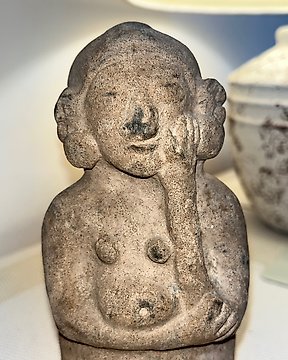
Tumaco-Tolita Terracotta Schwangere Frau in Denkposition - 23 cm
Nr. 83776927

Nr. 83776927

STELA OR CEREMONIAL METATE WITH TWO BOVIDS AND HUMAN HEADS
Nicoya-Guanacaste, Costa Rica, 800-1200 AD.
Volcanic Stone.
100 cm height and 43 cm length.
PROVENANCE: Private collection, Paris, France, 1970.
CONDITION: Good state of conservation, without restorations.
DESCRIPTION:
Piece in the shape of a rectangular plate, with a slight concavity in its central area, carved in volcanic stone with reliefs on its front and smooth back. The finish, in the form of a curved pediment, is composed of the relief figures of two confronting bovids on an openwork background. The animals appear joined by their front legs, the rear legs resting on the ground, with the body in profile and the face turned towards the viewer. Under the pediment there is a wide band with three incised blades. The profiles of the long sides of the piece are carved in relief with trophy heads placed on top of each other. The lower finish of the piece takes the form of a wide border, worked with incised lines composing a geometric design of parallel concentric lines, which fill the entire space. The central surface of the stele is completely smooth, empty of ornamentation.
The faces of the trophy heads and animals are carved in the same style, based on parallel horizontal bands, highlighted in relief: forehead, eyes, cheekbones and mouth. In the center, as a vertical axis, a wide and thick nose. The eyes and mouth are elongated, worked as horizontal bulges with a central slit.
The elongated rectangular shape and the absence of decoration in the large central space indicate that the piece could be a stele, or a metate for ceremonial use. In the case of the first option, the central surface would probably be painted. To date, the exact function of the Costa Rican stelae is not known, mainly due to the few examples found, although the appearance of some in funerary contexts (fig. 1) suggests that one of their uses could have been to indicate the presence of the tomb of an important person. In that case, the animal motifs would have alluded to the clan of the deceased.
If it were a metate or hand mill, it would in any case be a piece not for use but of a ritual or ceremonial nature, given that it reaches a meter in length, lacks legs and would not be very resistant due to the thin thickness of the stone. In the Guanacaste-Nicoya culture, ceremonial metates carved in volcanic stone were common (fig. 2), decorated with relief and openwork motifs that would allude to their owner or their religious function, and would probably be related to propitiatory fertility ceremonies. of the fields, since the metate was an object used in daily life to grind corn, a staple food of the area.
Greater Nicoya is an archaeological region that covers northwest Costa Rica and the Pacific coast of Nicaragua. The Southern Subregion, or Guanacaste, occupies the Nicoya peninsula, the Tempisque River basin and the Guanacaste and Tilarán mountain ranges. This is an area with human occupation for about 10,000 years, and important remains of material culture in ceramics, carved stone and jade have already been found in the Tempisque period (500 BC - 300 AD). In the Bagaces period (300 - 800 AD) there was already a complex social organization that was reflected in a greater variety in burial formulas, which included the use of large stone blocks. Around the year 800, the territory of Guanacaste was occupied by Chorotega groups from the north, from the Valley of Mexico, who were fleeing Olmec domination. This migration will bring the cultural influence of the Mayans and form the germ of the Kingdom of Nicoya, one of the main pre-Columbian chiefdoms existing in Mesoamerica upon the arrival of the Spanish.
Notes:
- The piece includes authenticity certificate.
- The piece includes Spanish Export License.
- The seller guarantees that he acquired this piece according to all national and international laws related to the ownership of cultural property. Provenance statement seen by Catawiki.
So kaufen Sie auf Catawiki
1. Etwas Besonderes entdecken
2. Höchstgebot abgeben
3. Sichere Zahlung durchführen